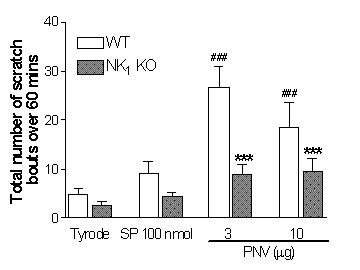| pA2 online © Copyright 2004 The British Pharmacological Society |
142P
GKT, University of London Winter Meeting December 2003 |
|
Role of
tachykinin NK1 receptors in Phoneutria
nigriventer spider venom-induced scratching |
|
Pain and itch sensations are induced by depolarization of C-fibre nerves and possibly other types of fibres. Andoh & Kuraish (2003) have shown that substance P (SP) induces itch-associated responses via activation of NK1 receptors in human and mouse skin. We have evidence from several species including mice that skin plasma extravasation induced by the spider venom Phoneutria nigriventer, (PNV) is dependent on tachykinin NK1 receptors (Costa et al., 2003). We have now investigated the itching (measured as bouts of scratches) observed in response to intradermal PNV in wildtype (WT) and NK1 receptor knockout (KO) mice.
Male and female mice (Sv129+C57BL/6; 25-30 g), either WT or NK1 receptor KO were anaesthetized with isoflurane in oxygen (2.5:2.5% by inhalation). 125I-BSA (0.03MBq/0.1 ml) was injected i.v. and a single intradermal injection (i.d.; 0.05 ml) of test agent or vehicle was made into the shaved dorsal skin. The bouts of mouse scratches were manually recorded by an investigator, who was unaware of nature of treatment, for 60 min. Oedema was concomitantly assessed by the extravascular accumulation of 125I-albumin. After 60 min, mice were anaesthetised, a blood sample taken by cardiac puncture and the mouse killed by cervical dislocation. The skin site was removed and oedema formation was assessed by extravascular accumulation of 125I-BSA present in the skin compared with plasma. Results are mean ± s.e.mean. Statistical analysis was by ANOVA + Bonferroni's modified t-test.
The i.d. injection of either substance P, up to a high dose (100nmol/site), or PNV (3-10 µg/site) induced oedema formation in WT but substantially less was observed in KO mice as (Costa et al., 2003). Scratching bouts were observed as shown in figure 1.
The results indicate less scratching bouts in KO as compared with WT mice. Interestingly, in contrast to findings by Andoh & Kuraishi, (2003) SP did not induce significant scratching at 100 nmol. Experiments with an NK1 receptor antagonist SR140333 (at doses that blocked PNV-induced oedema) revealed that whilst a local co-injection i.d. (1 nmol) in WT mice had no effect on PNV-induced scratching (18.5 ± 3.7 vs. 14.4 ± 3.5 bouts, n=7); a systemic treatment with SR140333 (120nmol/kg i.v.) significantly inhibited scratching (13.9 ± 3.5 vs. 3.1 ± 1.2 bouts, n=4-5; P<0.05).
Figure 1. Effect of agents on scratching. Data are mean ± s.e.mean, n = 5-8. P<0.001 (***) compared to WT group and (###) to Tyrode.

These results indicate that NK1 receptors are involved in mediating PNV-induced scratching and that the location of the receptors is unlikely to be skin. Thus a distinct separation between endogenous microvascular and nociceptive NK1-dependent effects is suggested.
Andoh, T. & Kuraishi,
Y. (2003). Br. J. Pharmacol, 138, 202-208.
Costa, S.K.P., Hyslop, S., Malcangio, M., Docherty, R.J., & Brain,
S.D (2003). Inflamm. res. 52 Suppl. 2 S85-88.
This study is supported by the British Heart Foundation.